Rail Travel's Decline (USA): 1950s-1970s
Last revised: September 6, 2024
By: Adam Burns
The decline of trail travel began following World War II, as traffic dropped significantly, even while railroads began to update their passenger fleets with new equipment in the 1950s.
The idea behind this endeavor was to retain passengers and ward off ever increasing competition from the automobile and airplane (the development of jet propulsion only worsened the situation).
Technically, passenger rail travel peaked in this country during the first two decades of the 20th century and slowly declined thereafter, particularly with the onset of the Great Depression.
However, it also did not help that President Dwight Eisenhower enacted the Interstate Highway System in 1956 (also known as the National Interstate and Defense Highways Act).
By that time railroads were beginning to see the writing on the wall and cutback their services, with most giving it up altogether by the start of Amtrak in 1971.
Photos
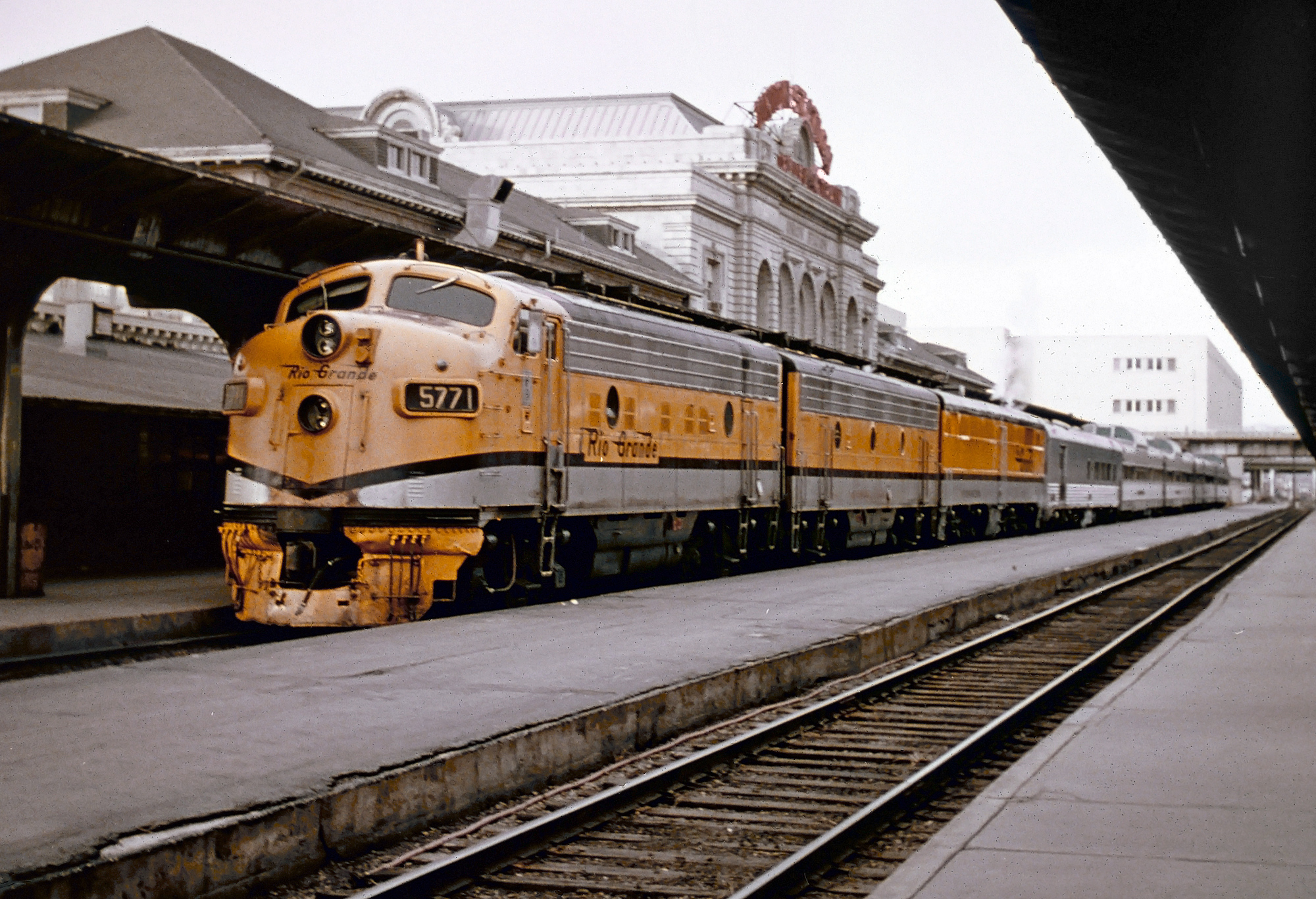 The Rio Grande continued to host a truncated version of the original "California Zephyr" until 1983, known as the "Rio Grande Zephyr." It operated only over D&RGW rails between Denver-Salt Lake City. Led by F9A #5771, the train is seen here at Denver Union Station on April 21, 1973. Joe Kmetz photo. American-Rails.com collection.
The Rio Grande continued to host a truncated version of the original "California Zephyr" until 1983, known as the "Rio Grande Zephyr." It operated only over D&RGW rails between Denver-Salt Lake City. Led by F9A #5771, the train is seen here at Denver Union Station on April 21, 1973. Joe Kmetz photo. American-Rails.com collection.History
Our high speed four lane corridors that we take for granted today did wonders in helping to improve travel but it was essentially the death blow for the “Golden Age” of passenger rail travel as people took to the highways in even greater numbers.
While new equipment in the 1950s helped bring back some passengers, overall the returns fell extremely short and in the end it only proved to be a costly waste of money as the decline only continued.
To make matters worse railroads were also losing a larger share of their bread and butter service, freight traffic to trucks that now had a high speed, free, and well maintained four-lane highway system to move goods.
While trucks are always more efficient at moving short-haul freight the new Interstate system was also taking away a larger share of the railroads’ long haul traffic.
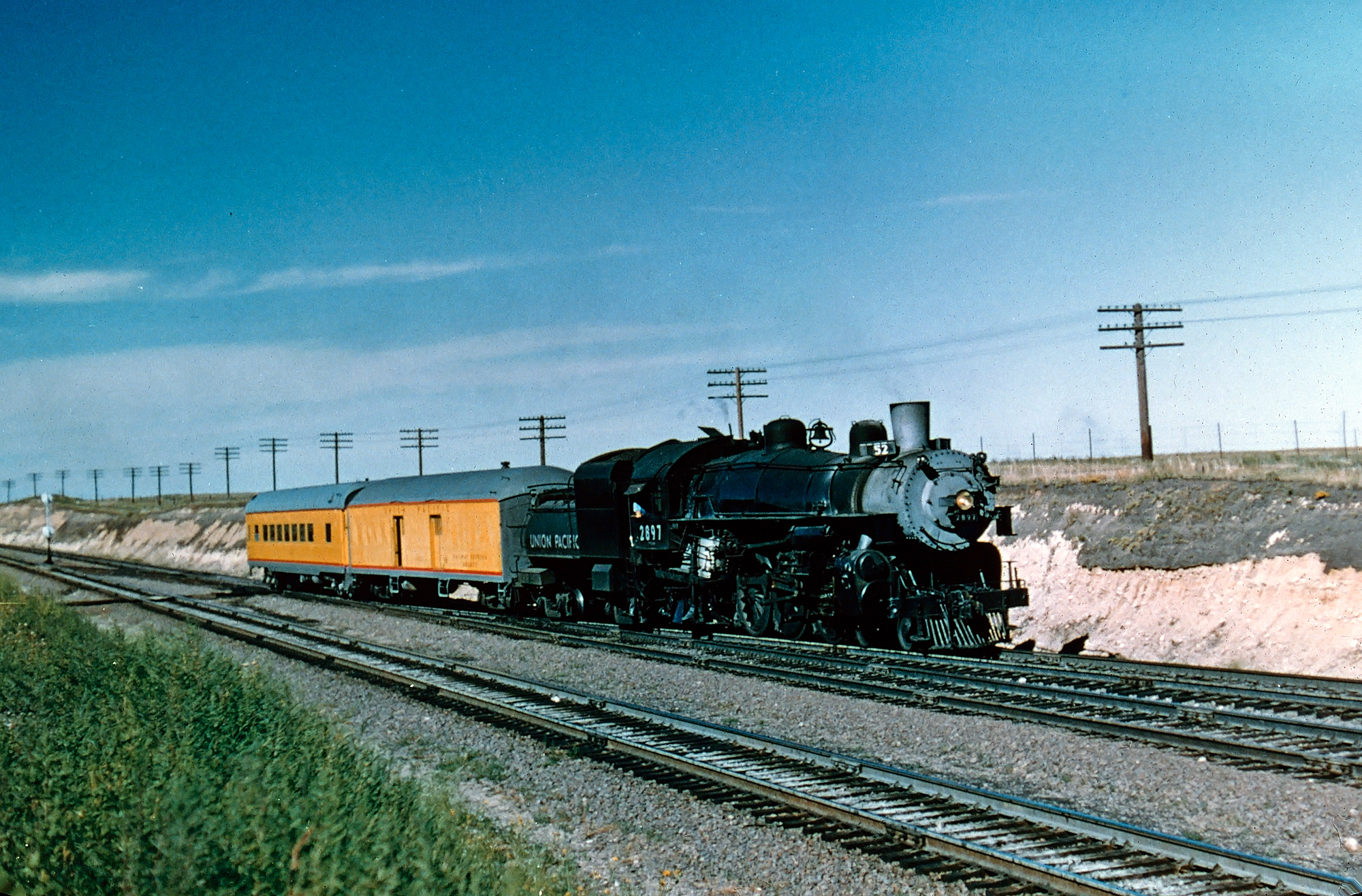 Union Pacific 4-6-2 #2897 has southbound train #52 (Cheyenne - Denver) working its way through Speer, Wyoming on August 31, 1955. John Shaw photo. American-Rails.com collection.
Union Pacific 4-6-2 #2897 has southbound train #52 (Cheyenne - Denver) working its way through Speer, Wyoming on August 31, 1955. John Shaw photo. American-Rails.com collection.Decline After World War II
For instance, by 1950 passenger revenue was 10 percent of freight revenue when in 1920 passenger revenue had been 20 percent of freight revenue.
While passenger trains are rarely profitable, before the 1950s railroads were earning enough that their freight revenues could easily offset the losses.
Also, in just a decades span between 1947 and 1957 operating mileage by passenger trains dropped from 160,000 (1947) to 112,000 (1957) and would continue into the following years.
It can be said (which is true) that one reason for the decline and the “depression” of the railroad industry as a whole, which occurred beginning in the 1950s until deregulation in 1980, is the result of severe sanctions and regulation by the Interstate Commerce Commission (ICC).
However, the railroads also, in a way, caused their own downfall by the shoddy and monopolistic practices they took part in during the 19th and early 20th centuries (which resulted in many of the regulations imposed on them). A few stats regarding the decline during these years:
- Between an 18-year span following the year after World War II, 1946, passenger traffic declined from 770 million to 298 million by 1964.
- By the 1950s total industry losses on passenger rail service was over $700 million.
- Commuter trains declined by 80% from over 2,500 in the mid-1950s to under 500 by the late 1960s.
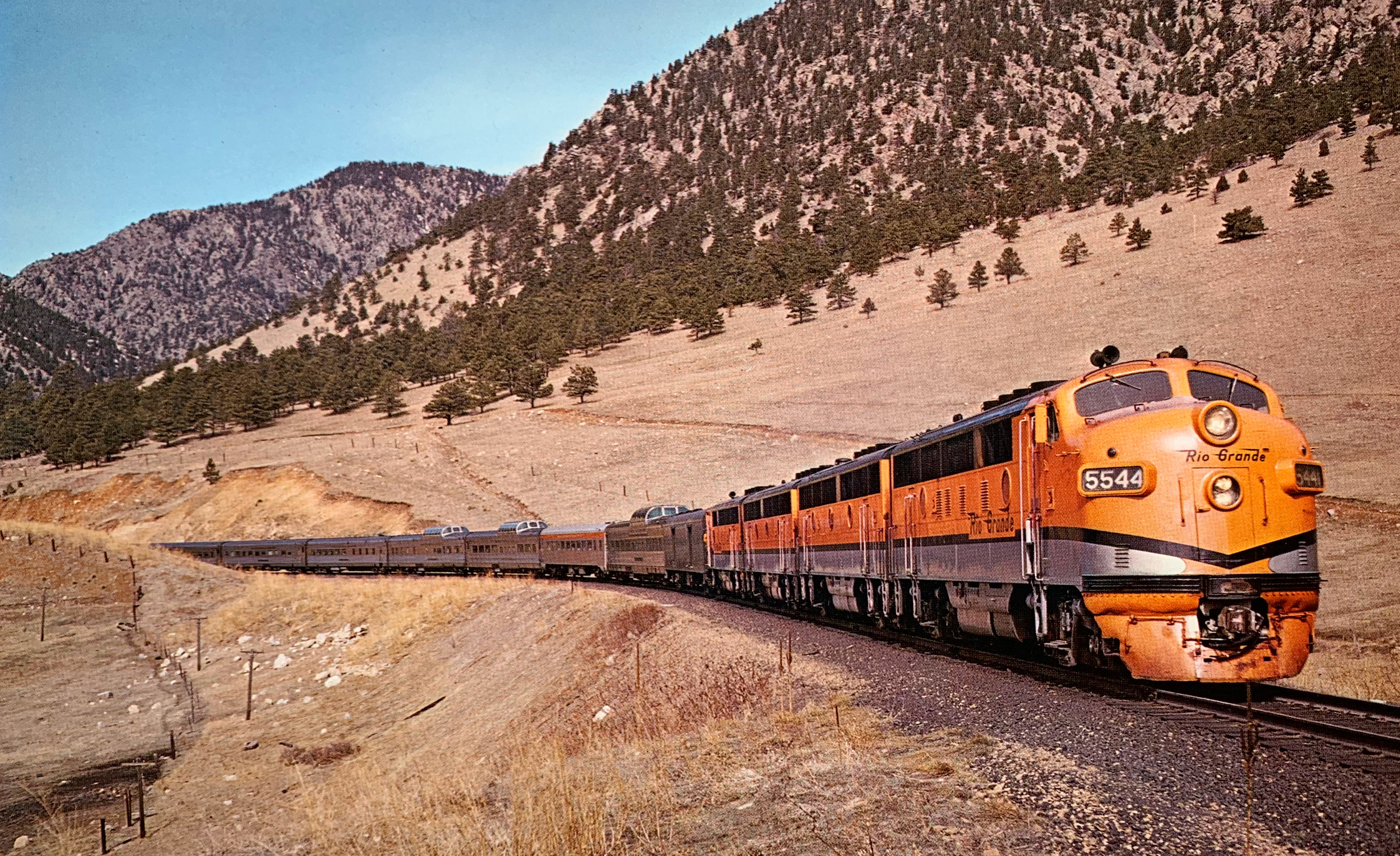 A Rio Grande publicity photo featuring the late-era "California Zephyr" headed west near Plainview, Colorado. Author's collection.
A Rio Grande publicity photo featuring the late-era "California Zephyr" headed west near Plainview, Colorado. Author's collection.In any event, by the 1960s three things were clear about the decline:
- One, because of the heavy regulation laid down on the industry it was no longer a threat to take part in such shoddy practices.
- Two, because railroads were forced to provide passenger service, which by now was only severely draining their profits if something was not done the industry would be near total collapse.
- Three, because of these heavy losses railroads desperately wanted to cut whatever they could to save money (which was tough considering heavy regulation forbid them from abandoning rail lines, canceling a passenger train[s], laying off workers, or raising/lowering freight charges all without ICC approval).
As a Boston & Maine official was once quoted as saying, "Every rate case has become a carnival of oratory." The 1960s also saw the end of the government’s lucrative mail contracts it held with the railroads and only furthered the decline as its loss was a severe blow to passenger traffic earnings.
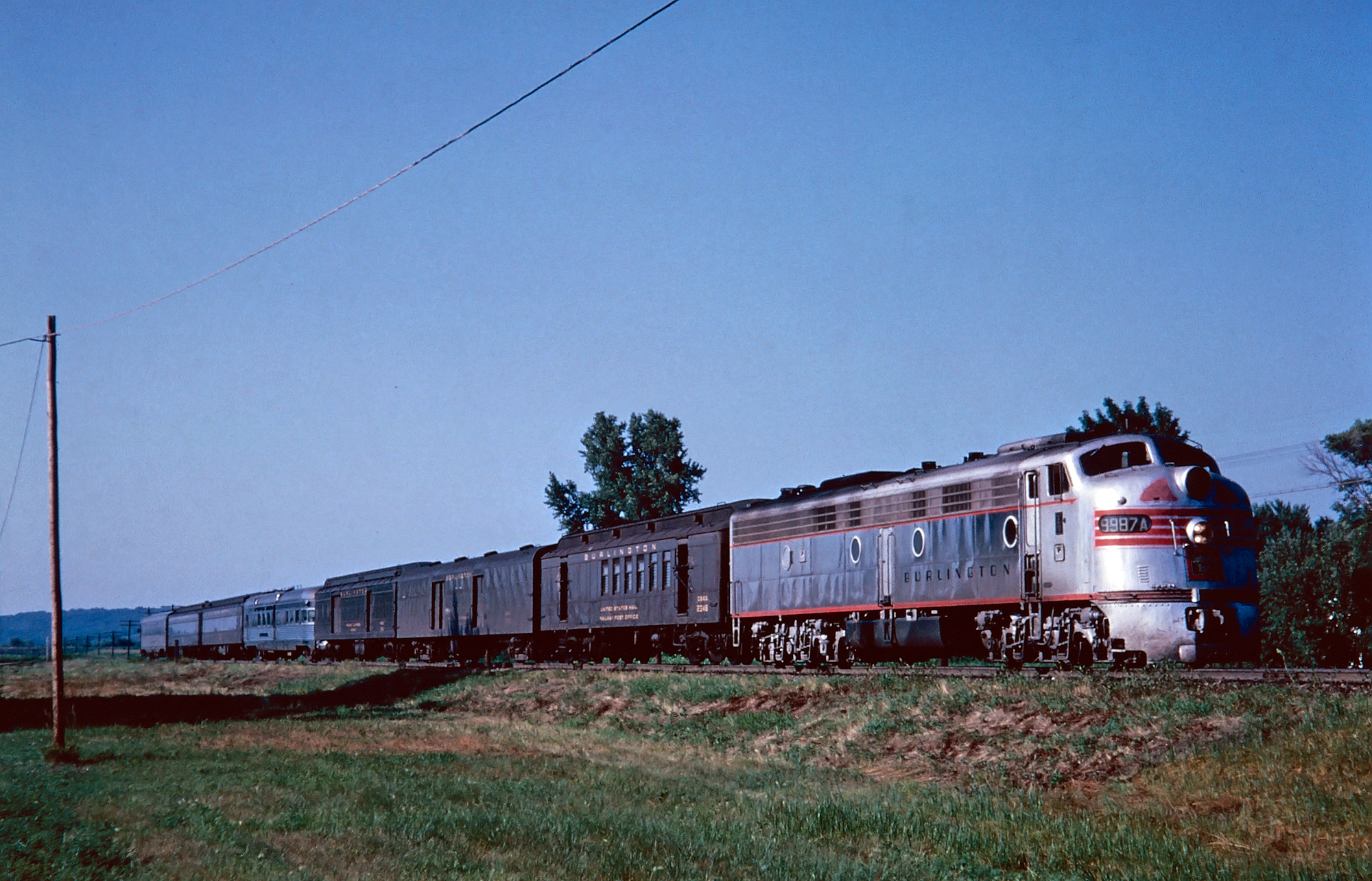 Burlington E9A #9987-A with the evening run between Kansas City and Omaha, circa 1966. This unit was involved in a horrific head-on collision at the interlocking in Montgomery, Illinois on September 27, 1964 when its train was misdirected into a waiting Rock Island passenger train detouring over the CB&Q. It later returned to service although the two other Burlington units involved were scrapped. American-Rails.com collection.
Burlington E9A #9987-A with the evening run between Kansas City and Omaha, circa 1966. This unit was involved in a horrific head-on collision at the interlocking in Montgomery, Illinois on September 27, 1964 when its train was misdirected into a waiting Rock Island passenger train detouring over the CB&Q. It later returned to service although the two other Burlington units involved were scrapped. American-Rails.com collection.Amtrak
Relief for passenger operations would finally come in the way of the National Railroad Passenger Corporation, or Amtrak, signed into law by President Richard Nixon as the Rail Passenger Service Act and the new carrier began operations on May 1st, 1971.
Government-controlled (all common stock is federally owned) and funded, Amtrak operates almost exclusively over the private freight railroads, save for the Northeast where it owns the [mostly] PRR’s former Northeast Corridor (NEC), a four-track main line operating between Washington, D.C. and Boston.
In total Amtrak operates roughly 21,000 miles of track. When it began operations railroads were asked to provide two things to the upstart passenger carrier:
- One-time payments, which would eventually total $190 million (from 13 railroads).
- Equipment (not all of the major Class I's elected to turn their operations over to Amtrak because they either felt they could provide better service or were not financially capable of doing so, such as the Rock Island).
In all, the equipment Amtrak would receive included 300 locomotives and over 1,200 cars.
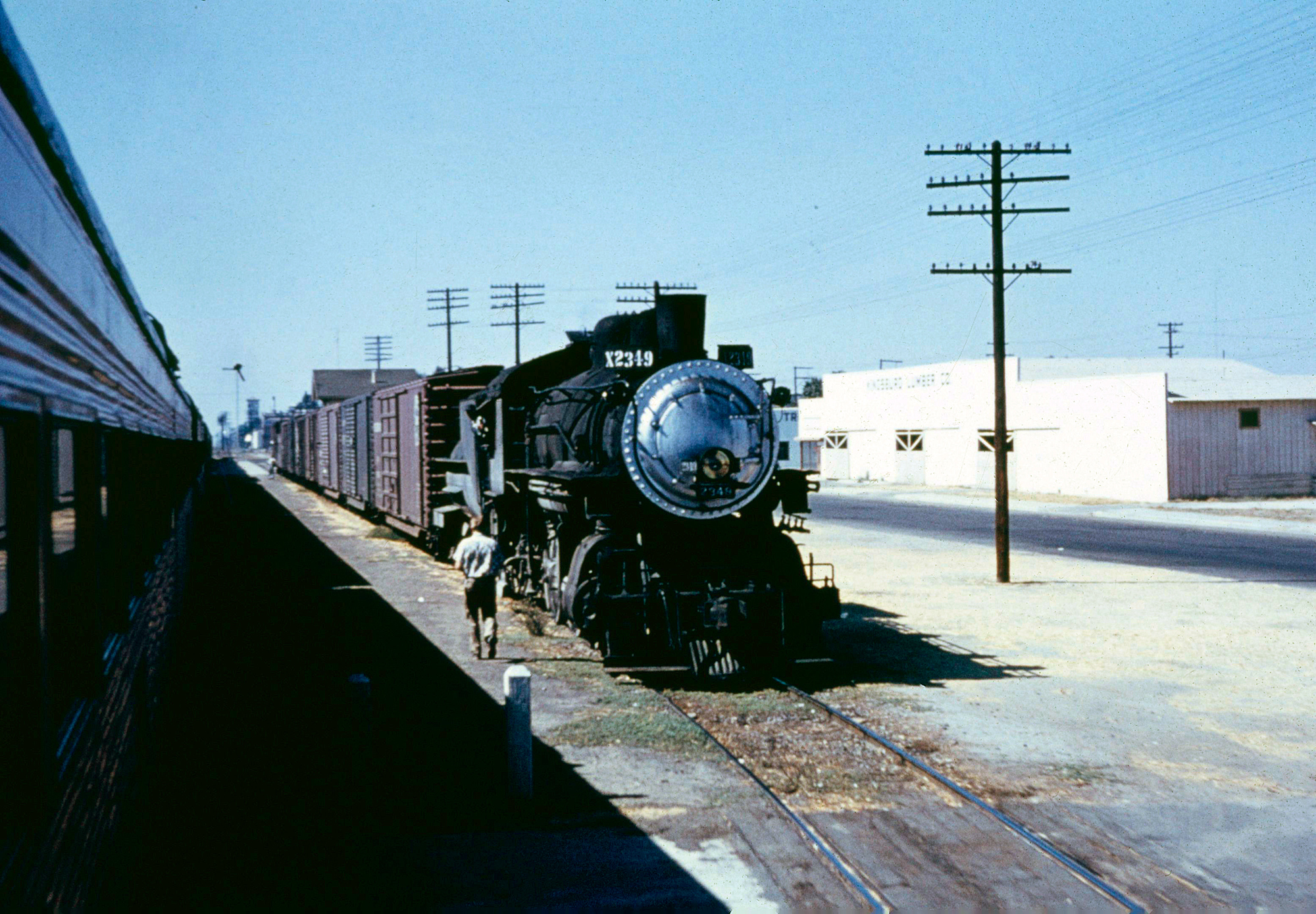 Taken aboard what was most likely Southern Pacific's "San Joaquin Daylight," Herb Cearley captured 2-8-0 #2349 working local service in Kingsburg, California during the 1950's. Author's collection.
Taken aboard what was most likely Southern Pacific's "San Joaquin Daylight," Herb Cearley captured 2-8-0 #2349 working local service in Kingsburg, California during the 1950's. Author's collection.Today
From a railfan perspective perhaps the most interesting time to watch Amtrak was during these early years when a train’s equipment hosted an entire assortment of liveries from railroads all over the country.
On the contrary, however, it was also disappointing to see a number of famous trains discontinued or canceled with Amtrak’s upstart.
While Amtrak was initially intended to become self-supporting (an improbable notion to begin with, passenger rail is rarely profitable) it quickly became obvious after its first year of operations this would not be the case.
In its first year Amtrak earned $163 million with expenses of $310 million. By 1980 things were not much better as the carrier saw $454 million in revenues and $1.08 billion in expenses.
Even though the decline of passenger railroading took place after World War II, until Amtrak’s creation in 1971 the carrier has been steadily improving and just in 2007 broke its all-time ridership record. For more on Amtrak regarding its early years through today please click here.
Recent Articles
-
Kentucky Christmas Train Rides On The "Santa Train"!
Dec 15, 25 11:10 PM
Where rail history and holiday magic meet in the heart of Kentucky’s horse country, the Bluegrass Scenic Railroad and its beloved Santa Trains offer families, railfans, and holiday enthusiasts an expe… -
Indiana Christmas Train Rides In La Porte!
Dec 15, 25 11:05 PM
Among the Hesston Steam Museum's standout events each year is the seasonal Santa’s Candy Cane Express, a holiday-themed train ride and festive morning-to-afternoon experience. -
California Christmas Train Rides In Campo!
Dec 15, 25 10:59 PM
Nestled in the Mountain Empire region of southeastern San Diego County, the Pacific Southwest Railway Museum. During the Christmas season they host the popular North Pole Limited.



